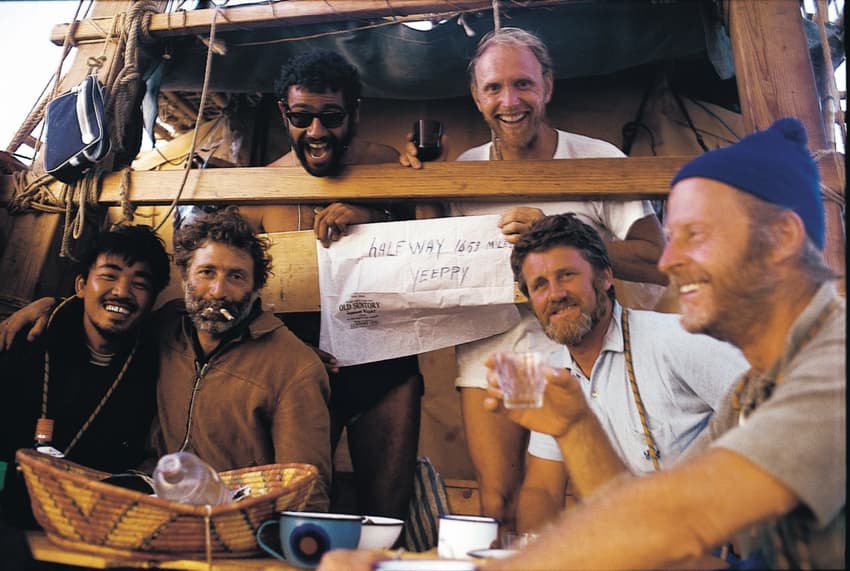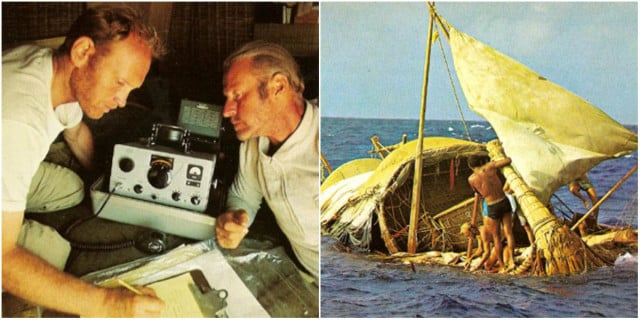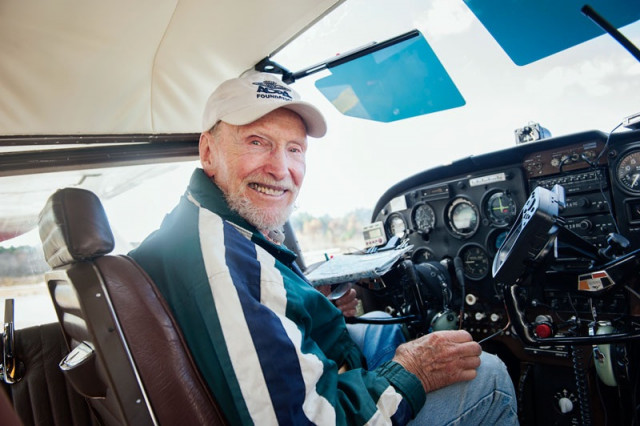Adventurer who was Thor Heyerdahl’s 'last crewmate' dies aged 89

Pilot, sailor and adventurer Norman Baker, the last living person to have sailed on legendary Norwegian anthropologist and explorer Thor Heyerdahl’s raft voyages, has died at the age of 89 after his light aircraft crashed in the United States.
An avid sailor and aviator throughout his life, Baker was found dead on November 23rd after the 1966 Cessna light aircraft he had been piloting crashed in a field in the state of Vermont. No other people were on board.
Baker, who lived in Windsor, Massachusetts, sailed as Heyerdahl’s celestial navigator during the Norwegian explorer’s trans-Atlantic crossings in boats built of papyrus reeds in 1969 and 1970.
The audacious journeys from Africa to the Caribbean attempted to show that ancient peoples could have made the ocean crossing – much like Heyerdahl’s earlier, celebrated trip across the Pacific Ocean on the Kon-Tiki raft, the voyage for which the Norwegian explorer is most famous.
Like Heyerdahl – who is an icon in Norway – Baker’s remarkable life story is bound by extraordinary tales of adventure.
Born in 1928 in Brooklyn, the young American took flying lessons at the age of 13, flew solo by 17 and also embarked on a career in the US Navy, eventually reaching the rank of Commander.
His first jobs included working as a labourer and later as an engineer with an Alaskan gold mining company; and marking out America’s last unsurveyed state boundary in the desert between Colorado and New Mexico.
“It is my belief that his life of adventure was sparked by the tales he read as a boy,” Mitchell Baker, one of three children left by the former Navy officer, told The Local via email.
“His favourite series was one called ‘Terry and The Pirates’, and the stories gave him a window to the world beyond New York City,” Mitchell Baker continued.
Baker first met Heyerdahl in the 1950s, his son said.
“It was a chance encounter post the Korean war in a bar in Tahiti when my father met Thor Heyerdahl. The conversation they began that night in the late 1950s would only end when Thor passed away,” Mitchell Baker told The Local.
“They were dear friends, and also peers. From Thor’s children’s notes of condolences recently, I know very well that the high regard my Dad had for Thor was returned to him in spades,” he continued.
Baker later joined Heyerdahl’s crew, serving as celestial navigator, radioman and second-in-command for two daring voyages across the Atlantic Ocean in the Ra and Ra II boats, in 1969 and 1970 respectively.
Similarly to the Kon-Tiki, the Ra boats were made from papyrus reeds. They were launched from the coast of Morocco in an attempt to reach the Caribbean islands.
The first voyage was abandoned when the Ra broke up after sailing over 6,440km. The second attempt made by Heyerdahl, Baker and the rest of the crew on the Ra II proved a success, eventually landing in Barbados, despite the boat becoming lost en route, initiating an international search.
The Ra II is now displayed at Oslo’s Kon-Tiki Museum.

L: Norman Baker (L) with Thor Heyerdahl in the cabin of the Ra II. R: A water-logged Ra I sinks in 1969. Both photos were taken by Carlo Mauri, another crew member on the voyages. Supplied by Mitchell Baker
Navigator Baker was also on board a third expedition on another reed boat, the Tigris, which was built in Iraq and sailed into the Red Sea in 1978. The Tigris was deliberately burnt in Djibouti on April 3rd, 1978, as a protest against wars in the Red Sea and Horn of Africa regions. It was Heyerdahl’s final raft expedition.
After the Ra voyages, Baker co-authored in 1974 a children’s book about the attempted crossings called Thor Heyerdahl and the Reed Boat Ra. In his later years, he turned his energy to other forms of adventure, including flying, canoeing, scuba diving, horseback riding and oceanography.
He was supported by his wife, Mary Ann Baker, who died in 2003.
“As a gift to my mother on their wedding day, he presented her with a pair of hiking boots. While my mother’s bridesmaids were all horrified at the unromantic gift, my mother understood the intent completely,” Mitchell Baker said.
“My mother said while she kept him grounded so he would not simply float away, it was he who ensured she never got stuck to the Earth in one place,” he continued.
In addition to working as an engineer, Baker was for nine years captain of the schooner Anne Kristine, a Norwegian ship built in 1868 and one of the oldest vessels plying the open seas at the time.
Along with his wife and three children, Baker used the Anne Kristine as both a home and a training and research vessel as they sailed up and down the east coast of the United States during the 1980s.
The vessel was lost in the infamous ‘Perfect Storm’ that hit the Atlantic coast of the United States and Canada in October 1991. Baker and his family were not aboard at the time and all nine crew members were rescued by the coast guard.

Norman Baker. Photo: Tracey Eller
He would go on to outlive his former captain Heyerdahl, who died in 2002 aged 87, by 15 years.
On November 22nd, Baker took off in his single-engine Cessna from the Pittsfield Municipal Airport, bound for Vermont and a Thanksgiving celebration with his three children, their partners, and seven grandchildren.
He had made the journey many times before, frequently flew alone and was known to airfield staff for his energy and fearlessness.
The wreckage of Baker’s 1966 Cessna was found on the morning of November 23rd by a local resident after it had been reported missing the previous evening.
The crash is under investigation by the US National Transportation Safety Board, according to coverage of the accident by the Boston Globe newspaper.
Pilot, sailor and engineer Baker “survived so many encounters with sharks, polar bears, Somali pirates, hurricanes, and countless other scary near-death situations,” his daughter Elizabeth Atwood told the Boston Globe, which originally reported on the accident and the pilot’s death last month.
“My dad was prepared and fearless and never let anything get in the way of his curiosity and joy in exploration. He would never have wanted to die in any diminished way, and as deeply sad as we are, my dad died doing something he truly loved.
“He shaped my entire life. He truly, truly inspired me and my husband and kids,” Atwood said.
READ ALSO: Kon-Tiki breaks Norway box office record
Comments
See Also
An avid sailor and aviator throughout his life, Baker was found dead on November 23rd after the 1966 Cessna light aircraft he had been piloting crashed in a field in the state of Vermont. No other people were on board.
Baker, who lived in Windsor, Massachusetts, sailed as Heyerdahl’s celestial navigator during the Norwegian explorer’s trans-Atlantic crossings in boats built of papyrus reeds in 1969 and 1970.
The audacious journeys from Africa to the Caribbean attempted to show that ancient peoples could have made the ocean crossing – much like Heyerdahl’s earlier, celebrated trip across the Pacific Ocean on the Kon-Tiki raft, the voyage for which the Norwegian explorer is most famous.
Like Heyerdahl – who is an icon in Norway – Baker’s remarkable life story is bound by extraordinary tales of adventure.
Born in 1928 in Brooklyn, the young American took flying lessons at the age of 13, flew solo by 17 and also embarked on a career in the US Navy, eventually reaching the rank of Commander.
His first jobs included working as a labourer and later as an engineer with an Alaskan gold mining company; and marking out America’s last unsurveyed state boundary in the desert between Colorado and New Mexico.
“It is my belief that his life of adventure was sparked by the tales he read as a boy,” Mitchell Baker, one of three children left by the former Navy officer, told The Local via email.
“His favourite series was one called ‘Terry and The Pirates’, and the stories gave him a window to the world beyond New York City,” Mitchell Baker continued.
Baker first met Heyerdahl in the 1950s, his son said.
“It was a chance encounter post the Korean war in a bar in Tahiti when my father met Thor Heyerdahl. The conversation they began that night in the late 1950s would only end when Thor passed away,” Mitchell Baker told The Local.
“They were dear friends, and also peers. From Thor’s children’s notes of condolences recently, I know very well that the high regard my Dad had for Thor was returned to him in spades,” he continued.
Baker later joined Heyerdahl’s crew, serving as celestial navigator, radioman and second-in-command for two daring voyages across the Atlantic Ocean in the Ra and Ra II boats, in 1969 and 1970 respectively.
Similarly to the Kon-Tiki, the Ra boats were made from papyrus reeds. They were launched from the coast of Morocco in an attempt to reach the Caribbean islands.
The first voyage was abandoned when the Ra broke up after sailing over 6,440km. The second attempt made by Heyerdahl, Baker and the rest of the crew on the Ra II proved a success, eventually landing in Barbados, despite the boat becoming lost en route, initiating an international search.
The Ra II is now displayed at Oslo’s Kon-Tiki Museum.

L: Norman Baker (L) with Thor Heyerdahl in the cabin of the Ra II. R: A water-logged Ra I sinks in 1969. Both photos were taken by Carlo Mauri, another crew member on the voyages. Supplied by Mitchell Baker
Navigator Baker was also on board a third expedition on another reed boat, the Tigris, which was built in Iraq and sailed into the Red Sea in 1978. The Tigris was deliberately burnt in Djibouti on April 3rd, 1978, as a protest against wars in the Red Sea and Horn of Africa regions. It was Heyerdahl’s final raft expedition.
After the Ra voyages, Baker co-authored in 1974 a children’s book about the attempted crossings called Thor Heyerdahl and the Reed Boat Ra. In his later years, he turned his energy to other forms of adventure, including flying, canoeing, scuba diving, horseback riding and oceanography.
He was supported by his wife, Mary Ann Baker, who died in 2003.
“As a gift to my mother on their wedding day, he presented her with a pair of hiking boots. While my mother’s bridesmaids were all horrified at the unromantic gift, my mother understood the intent completely,” Mitchell Baker said.
“My mother said while she kept him grounded so he would not simply float away, it was he who ensured she never got stuck to the Earth in one place,” he continued.
In addition to working as an engineer, Baker was for nine years captain of the schooner Anne Kristine, a Norwegian ship built in 1868 and one of the oldest vessels plying the open seas at the time.
Along with his wife and three children, Baker used the Anne Kristine as both a home and a training and research vessel as they sailed up and down the east coast of the United States during the 1980s.
The vessel was lost in the infamous ‘Perfect Storm’ that hit the Atlantic coast of the United States and Canada in October 1991. Baker and his family were not aboard at the time and all nine crew members were rescued by the coast guard.

Norman Baker. Photo: Tracey Eller
He would go on to outlive his former captain Heyerdahl, who died in 2002 aged 87, by 15 years.
On November 22nd, Baker took off in his single-engine Cessna from the Pittsfield Municipal Airport, bound for Vermont and a Thanksgiving celebration with his three children, their partners, and seven grandchildren.
He had made the journey many times before, frequently flew alone and was known to airfield staff for his energy and fearlessness.
The wreckage of Baker’s 1966 Cessna was found on the morning of November 23rd by a local resident after it had been reported missing the previous evening.
The crash is under investigation by the US National Transportation Safety Board, according to coverage of the accident by the Boston Globe newspaper.
Pilot, sailor and engineer Baker “survived so many encounters with sharks, polar bears, Somali pirates, hurricanes, and countless other scary near-death situations,” his daughter Elizabeth Atwood told the Boston Globe, which originally reported on the accident and the pilot’s death last month.
“My dad was prepared and fearless and never let anything get in the way of his curiosity and joy in exploration. He would never have wanted to die in any diminished way, and as deeply sad as we are, my dad died doing something he truly loved.
“He shaped my entire life. He truly, truly inspired me and my husband and kids,” Atwood said.
READ ALSO: Kon-Tiki breaks Norway box office record
Join the conversation in our comments section below. Share your own views and experience and if you have a question or suggestion for our journalists then email us at [email protected].
Please keep comments civil, constructive and on topic – and make sure to read our terms of use before getting involved.
Please log in here to leave a comment.